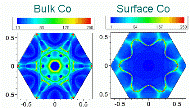Department of Physics and Astronomy: Publications and Other Research

Gordon Gallup Publications
Document Type
Article
Date of this Version
2-1-1993
Abstract
The laboratory energy distribution of protons in coincidence with an H- ion, resulting from the dissociation of excited H3+, has been measured for H+-H- pairs emitted along the beam for 4.0-keV H3+-He collisions. An approximate energy distribution of H+-H- pairs for the collinear configuration of the dissociation products is obtained by transforming the measured laboratory spectrum to the H3+ center-of-mass (c.m.) frame. Coincidence data suggest that the reaction producing H+-H- pairs where the H+ ion has near-zero energies (3+ ions using a full configuration-interaction calculation with a basis set of atomic orbitals consisting of 1s, 1s’, 1p’, 2s, and 2p centered on the protons forming an isosceles (C2vsymmetry) or an equilateral (D3h symmetry) triangle. The states leading to asymptotic H++H++H- limits have been identified by calculating 〈1/r12〉-1, the inverse of the expectation value of the electron-electron repulsion term. The states identified by this procedure have adiabatic Born-Oppenheimer energies of 40–45 eV above the H3+ ground state at the H3+ equilibrium separation. The limits on the total available internal energy to be shared by the three dissociation products that one obtains from the experimentally determined H+-H- coincidence spectrum are consistent with the identified H3+ excited states.


Comments
Published by American Physical Society. Phys. Rev. A 47, 1059 (1993). http://pra.aps.org. Copyright © 1993 American Physical Society. Permission to use.